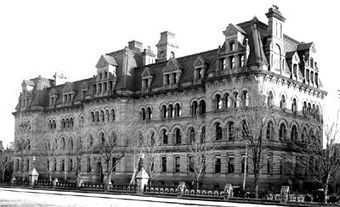Canadian Security Intelligence Service
The Canadian Security Intelligence Service (CSIS) was created by Act of Parliament in 1984 as an agency of the Department of the Solicitor General. The agency's first director was Thomas D'Arcy Finn (1984-87), a lawyer and career public servant. CSIS's purpose is to conduct security investigations within Canada related to suspected subversion, TERRORISM and foreign espionage and sabotage. In its first years of existence, its priority was the investigation of terrorist groups because of a number of violent crimes with political overtones, including the bombing of an Air India jet on a flight from Montréal and the armed takeover of the Turkish embassy in Ottawa. The service monitors racist and other hate groups and, in one well-publicized operation, recruited an informant in one of the most prominent of the white supremacist groups in Canada, the Heritage Front. Counter-subversion operations all but ceased after the Cold War. CSIS also conducts background investigations of public servants whose positions require them to hold a high-level security clearance because they have access to sensitive national security information. The service also provides security checks of applicants for immigration and Canadian citizenship.
CSIS replaced the security service of the ROYAL CANADIAN MOUNTED POLICE. Many of its first members transferred directly to the civilian agency from the federal police force. Although CSIS members are not police officers, the agency can obtain judicial warrants to conduct searches and electronic surveillance, such as telephone wiretapping. CSIS does not conduct regular intelligence operations in foreign countries, but its members share intelligence and work closely with other security services abroad under various agreements. Former "enemy" or adversary services, such as the Foreign Intelligence Service of Russia, became allies in the fight against global terrorism after the end of the Cold War. But traditional adversaries also continued to run intelligence operations within Canada well into the 1990s, as was evidenced by the 1996 discovery by CSIS of 2 Russian intelligence officers, Yelena B. Olshanskaya and Dmitriy V. Olshanskiy, living in Toronto under the assumed names of Laurie and Ian Lambert.
CSIS was the result of a reform of the RCMP after officers in the force were discovered to have used illegal investigative techniques such as mail-opening operations and break-ins. A federal royal commission (the McDonald Commission) recommended the creation of a new civilian agency. In an effort to prevent similar abuses by the new agency, Parliament set up 2 review mechanisms. The 5-member Security Intelligence Review Committee (SIRC) and the CSIS inspector general can examine all aspects of CSIS's operations and can report any irregularities directly to the solicitor general, who is a minister in the federal Cabinet. The SIRC also presents an annual report to Parliament. Nevertheless, in late 1987 director T.D. Finn resigned over allegations of improper activities. CSIS was accused of violating civil liberties and spying on the labour movement, and the government announced a major reorganization.
CSIS maintains headquarters in Ottawa, has field offices in major Canadian cities and posts liaison officers to the capitals of allied countries. With the end of the Cold War and the subsequent decrease in the relative importance of counter-intelligence operations, CSIS went from a peak of 2760 employees in 1992 to about 2000 employees 5 years later. The agency recruits its members from other areas of the public service and from the general population. Lawyer Ron Atkey was the first chairman of the SIRC, Richard Grosse the first CSIS inspector general. New members are given extensive specialized secret training at their headquarters in Ottawa.

 Share on Facebook
Share on Facebook Share on X
Share on X Share by Email
Share by Email Share on Google Classroom
Share on Google Classroom

